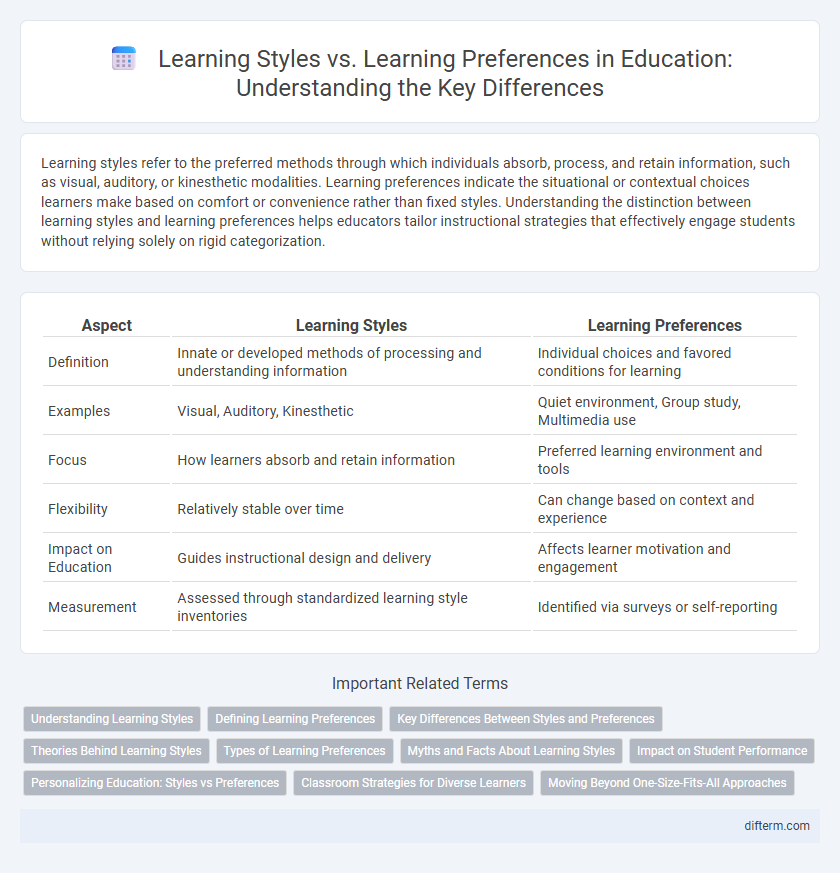Learning styles refer to the preferred methods through which individuals absorb, process, and retain information, such as visual, auditory, or kinesthetic modalities. Learning preferences indicate the situational or contextual choices learners make based on comfort or convenience rather than fixed styles. Understanding the distinction between learning styles and learning preferences helps educators tailor instructional strategies that effectively engage students without relying solely on rigid categorization.
Table of Comparison
| Aspect | Learning Styles | Learning Preferences |
|---|---|---|
| Definition | Innate or developed methods of processing and understanding information | Individual choices and favored conditions for learning |
| Examples | Visual, Auditory, Kinesthetic | Quiet environment, Group study, Multimedia use |
| Focus | How learners absorb and retain information | Preferred learning environment and tools |
| Flexibility | Relatively stable over time | Can change based on context and experience |
| Impact on Education | Guides instructional design and delivery | Affects learner motivation and engagement |
| Measurement | Assessed through standardized learning style inventories | Identified via surveys or self-reporting |
Understanding Learning Styles
Learning styles refer to the characteristic ways individuals absorb, process, and retain information, categorized into visual, auditory, and kinesthetic modalities. Understanding learning styles enables educators to tailor instructional methods that enhance student engagement and information retention. Research emphasizes the importance of aligning teaching strategies with students' dominant learning styles to optimize educational outcomes.
Defining Learning Preferences
Learning preferences refer to an individual's favored way of absorbing, processing, and retaining information, such as visual, auditory, or kinesthetic modes. These preferences influence how learners engage with educational material and optimize their study habits. Understanding learning preferences helps educators design instruction tailored to students' unique needs, enhancing comprehension and retention.
Key Differences Between Styles and Preferences
Learning styles refer to the consistent ways individuals process and retain information, such as visual, auditory, or kinesthetic modalities, while learning preferences are the subjective choices or comfort levels a learner expresses toward particular methods or environments. Styles represent innate cognitive approaches supported by psychological theories, whereas preferences are influenced by personal experiences and situational factors, often changing over time. Understanding the distinction enhances educational strategies by aligning instructional design with both neurological tendencies and learners' favored conditions, improving engagement and retention.
Theories Behind Learning Styles
Theories behind learning styles primarily stem from cognitive psychology models such as Fleming's VARK, which categorizes learners by sensory modalities: Visual, Auditory, Reading/Writing, and Kinesthetic. Howard Gardner's Multiple Intelligences theory expands this concept by proposing diverse intelligences like linguistic, logical-mathematical, and bodily-kinesthetic, emphasizing individual strengths in processing information. These theoretical frameworks highlight the importance of tailoring educational strategies to accommodate distinct learning profiles for improved knowledge retention and engagement.
Types of Learning Preferences
Learning preferences refer to the individual's favored ways of absorbing, processing, and retaining information, often categorized into visual, auditory, reading/writing, and kinesthetic types. Visual learners benefit from images, diagrams, and spatial understanding, while auditory learners excel through listening and verbal instructions. Reading/writing learners prefer interacting with text-based information, and kinesthetic learners engage best through hands-on activities and movement.
Myths and Facts About Learning Styles
Learning styles, such as visual, auditory, and kinesthetic, are often misunderstood as fixed categories that determine how individuals learn best; however, research shows limited evidence supporting their effectiveness in improving educational outcomes. Learning preferences refer to the favored ways individuals choose to engage with material, which may vary depending on context and content complexity. Debunking myths about learning styles emphasizes the importance of adaptable teaching methods tailored to diverse cognitive processes rather than rigid style classifications.
Impact on Student Performance
Learning styles, such as visual, auditory, and kinesthetic, influence how students process information, directly impacting their academic performance by tailoring instructional methods to individual cognitive strengths. Learning preferences reflect students' favored environments and activities, which, when accommodated, enhance engagement and motivation, thereby improving retention and comprehension. Effective differentiation that considers both learning styles and preferences leads to optimized student outcomes and higher overall performance in educational settings.
Personalizing Education: Styles vs Preferences
Personalizing education requires distinguishing between learning styles--cognitive approaches such as visual, auditory, or kinesthetic methods--and learning preferences, which reflect individual comfort or choice in learning environments and materials. Research emphasizes that tailoring instruction based on learning preferences enhances engagement and motivation, while adapting to learning styles may improve content comprehension and retention. Integrating both elements creates a more effective, student-centered approach to education, optimizing outcomes by addressing diverse cognitive and emotional needs.
Classroom Strategies for Diverse Learners
Classroom strategies for diverse learners must account for both learning styles and learning preferences to enhance student engagement and comprehension. Incorporating multimodal instruction--such as visual aids, auditory materials, and kinesthetic activities--addresses varied sensory modalities and cognitive processing techniques. Personalizing feedback and flexible grouping further supports differentiated learning, fostering an inclusive educational environment.
Moving Beyond One-Size-Fits-All Approaches
Learning styles categorize how individuals absorb information, such as visual, auditory, or kinesthetic methods, but research shows that rigid adherence to these categories may limit educational effectiveness. Learning preferences highlight students' favored ways to engage with material, supporting more personalized and flexible teaching strategies. Moving beyond one-size-fits-all approaches encourages adaptive learning environments that address diverse needs and promote deeper understanding.
Learning styles vs Learning preferences Infographic

 difterm.com
difterm.com